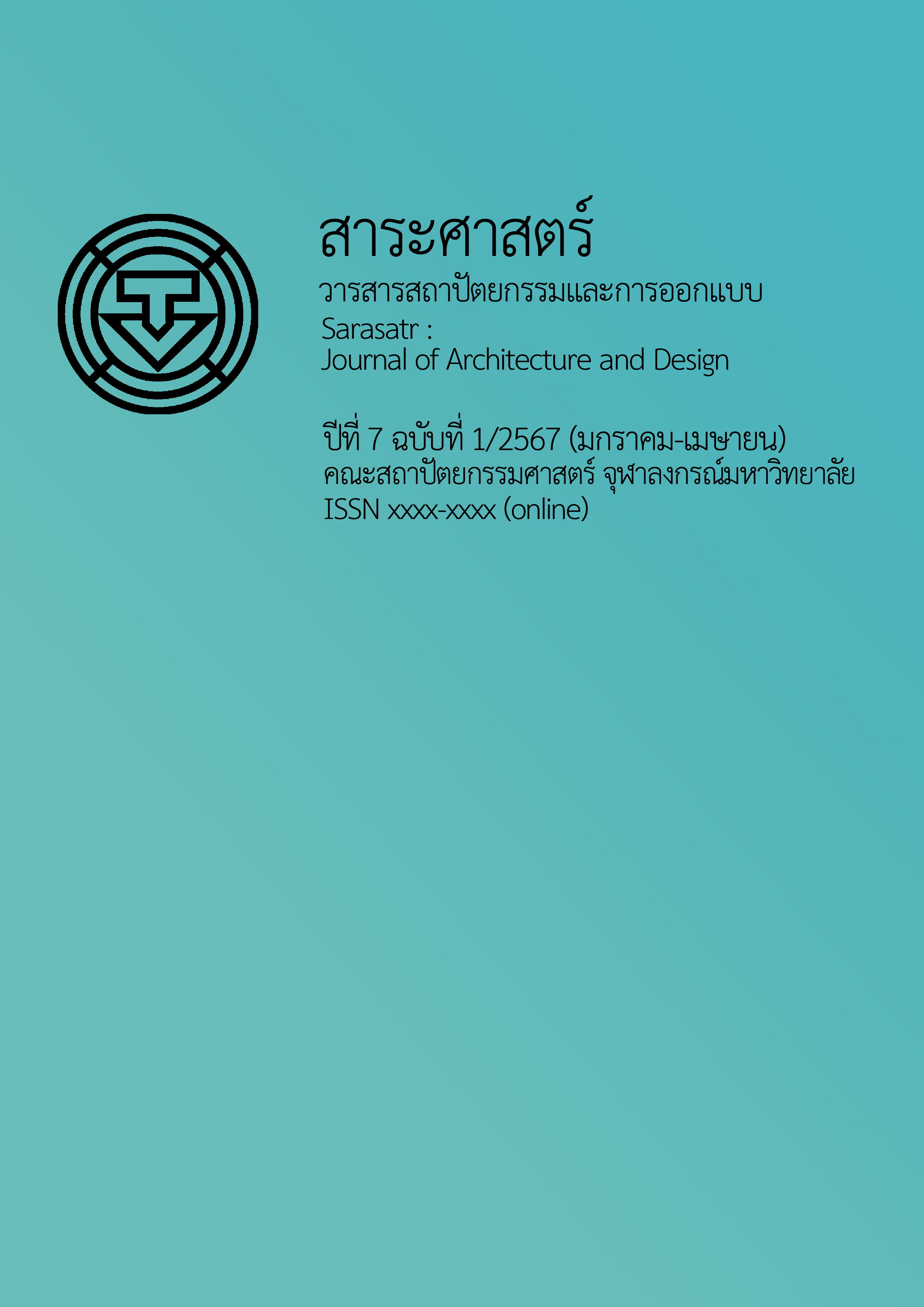Factors Affecting Travelling Behavior around Mass Transit Stations
Main Article Content
Abstract
Transit-oriented development (TOD) is an important elements in urban planning. It encourages people to travel by public transportation to connect many areas. Most countries, particularly Thailand have prioritized land development around rail transit stations focused travelling behavior of individuals as it is very important to TOD development. The objectives of this article are as follows: 1) to review and synthesize literatures and researches related to travelling behavior and travelling behavior by rail transit system. 2) to identify gaps identifying factors affecting travelling behavior around mass transit stations in Thailand. This study would encourage sustainable development of feeders that certainly connect the rail transit system in the future.
Article Details
References
ชยางกูร เนื่องอำพร. (2565). พฤติกรรมการเดินทางด้วยรถโดยสารประจำทางท่าอากาศยานดอนเมือง. สาระศาสตร์, 1, 91-101.
ดวงพร กาซาสบิ, สิริทิพ วะศินรัตน์, และศิริวิมล สายเวช. (2560). การวิเคราะห์ปัจจัยด้านคมนาคมขนส่งระบบรองและสิ่งแวดล้อมสรรค์สร้างที่ส่งผลต่อการเลือกใช้รถไฟฟ้าสายสีแดงด้วยเทคนิคการสำรวจแบบจำลองสถานการณ์ :กรณีศึกษาสถานีมหาวิทยาลัยธรรมศาสตร์ศูนย์รังสิต. วารสารจันทรเกษมสาร, 23(44), 130-141.
ทรงยศ อยู่สุข. (2557). การศึกษาศักยภาพในการรองรับการขยายตัวทางประชากรเพื่อการพัฒนาพื้นที่ตามแนวทาง TOD กรณีศึกษา : สถานีรถไฟฟ้าอ่อนนุชและสถานีรถไฟฟ้าสมุทรปราการ [วิทยานิพนธ์ปริญญามหาบัณฑิต ไม่ได้ตีพิมพ์]. มหาวิทยาลัยธรรมศาสตร์.
นรุตม์ พูลรส. (2559). รูปแบบการใช้ประโยชน์ที่ดินและการเดินทางเข้าถึงสถานีของผู้อยู่อาศัยในอาคารชุดรอบสถานีรถไฟฟ้าบีทีเอส [วิทยานิพนธ์ปริญญามหาบัณฑิต ไม่ได้ตีพิมพ์]. จุฬาลงกรณ์มหาวิทยาลัย.
ปัทมพร วงศ์วิริยะ. (2565). ปัจจัยที่มีอิทธิพลต่อการปรับเปลี่ยนพฤติกรรมการเดินทางเพื่อส่งเสริมการใช้ระบบขนส่งสาธารณะภายในเมืองขอนแก่น. วารสารสิ่งแวดล้อมสรรค์สร้างวินิจฉัย คณะสถาปัตยกรรมศาสตร์ มหาวิทยาลัยขอนแก่น, 21, 57-71. https://doi.org/https://DOI=10.14456/bei 2022.14
พนิต ภู่จินดา. (2556). ความรู้พื้นฐานเกี่ยวกับระบบขนส่งมวลชน. สำนักพิมพ์จุฬาลงกรณ์มหาวิทยาลัย.
พุทธมนต์ รตจีน. (2559). การพัฒนาพื้นที่โดยรอบสถานีขนส่งมวลชน (Transit-Oriented-Development). สำนักงานนโยบายและแผนการขนส่งและจราจร.
ภัทรพร เนติปัญญา. (2548). ความสามารถในการเข้าถึงสถานีรถไฟฟ้าขนส่งมวลชน : กรณีศึกษาผู้เดินทางไปทางานในเขตเมืองกรุงเทพมหานคร [วิทยานิพนธ์ปริญญามหาบัณฑิต ไม่ได้ตีพิมพ์]. จุฬาลงกรณ์มหาวิทยาลัย.
ภาวิณี เอี่ยมตระกูล. (2561). การวางแผนเมืองและพัฒนาระบบขนส่ง. โรงพิมพ์มหาวิทยาลัยธรรมศาสตร์.
ภาวิณี เอี่ยมตระกูล, ไอศูรย์ เรืองรัตนอัมพร, และ ภัททิยา ชินพิริยะ. (2017). กรอบการวิเคราะห์นโยบายการวางแผนการพัฒนาพื้นที่บริเวณรอบสถานีขนส่งมวลชนเพื่อการพัฒนาเมืองอย่างยั่งยืน. JARS, 14(1), 95-122.
ภูริณัฐ ธนวิบูลย์ชัย. (2557). ปัจจัยที่มีผลต่อการตัดสินใจเลือกซื้อที่อยู่อาศัยในเขตกรุงเทพมหานครและปริมณฑลของพนักงานบริษัทเอกชน [วิทยานิพนธ์ปริญญามหาบัณฑิต ไม่ได้ตีพิมพ์]. มหาวิทยาลัยธรรมศาสตร์.
วเรศรา วีระวัฒน์ และทักษพร ทองบุญเพียร. (2561). การศึกษารูปแบบการเดินทางด้วยระบบขนส่งเสริมสำหรับสถานีรถไฟฟ้าเตาปูน. วารสารวิชาการเทคโนโลยีอุตสาหกรรม, 14(1), 40-49.
วิโรจน์ รุโจปการ. (2544). การวางแผนการขนส่งเขตเมือง (พิมพ์ครั้งที่ 2). ภาควิชาวิศวกรรมโยธา คณะวิศวกรรมศาสตร์ มหาวิทยาลัยเกษตรศาสตร์.
สมศิริ เชียววัฒนกุล. (2022). TOD แนวทางการพัฒนาเมือง และชุมชนอย่างยั่งยืน. https://www.eg.mahidol.ac.th/dept/clare/en/all-news-1column/124-transit-oriented-developmenttod.html
สำนักการวางแผนและพัฒนาเมือง กรุงเทพมหานคร. (2563). รายงานการศึกษาระบบขนส่งเสริม (Feeder System) ตามแนวรถไฟฟ้าขนส่งมวลชน กรณีศึกษาสถานีบางหว้า. https://shorturl.asia/zEVq7
สำนักงานนโยบายและแผนการขนส่งและจราจร. (2564). รายงานฉบับสมบูรณ์โครงการศึกษาพัฒนาเมืองกับระบบโครงสร้างพื้นฐานด้านคมนาคมขนส่ง. สำนักงาน.
อัจฉรา ลิ้มมณฑล. (2564). ทิศทางการพัฒนาระบบขนส่งมวลชนในเมืองหลักภูมิภาคและแนวทางการพัฒนาพื้นที่โดยรอบสถานี. วารสารการขนส่งและโลจิสติกส์, 1(13), 9-39.
Uma Pupphachai. (2018). แนวคิดการพัฒนาเมืองตามแนวระบบขนส่งมวลชน. https://medium.com/umapupphachai/transit-oriented-development-tod-85c52888962d
เอกวัฒน์ พันธาสุ และมนสิชา เพชรานนท์. (2554). พฤติกรรมการเดินทางในเมืองหลักของภูมิภาค : กรณีศึกษาเมืองเชียงใหม่. วารสารวิชาการ คณะสถาปัตยกรรมศาสตร์ มหาวิทยาลัยขอนแก่น, 10, 74-91.
Adolphson, M. (2022). Urban morphology, lifestyles and work-related travel behaviour: Evidence from the Stockholm region. Transportation Research Interdisciplinary Perspectives, 16, 100706. https://doi.org/https://doi.org/10.1016/j.trip.2022.100706
Bian, F., Qiao, S., & Yeh, A. G.-O. (2023, October). Mobility resilience: Transit-oriented development, ride-hailing, and car ownership. Transportation Research Part D: Transport and Environment, 123(3), 103924. https://doi.org/10.1016/j.trd.2023.103924
Bruton, M. J. (1975). Introduction to transportation planning. Hutchinson.
Calthorpe, P. (1993). The next American metropolis ecology, community, and the American dream. Princeton Architectural Press.
Faber, R., Merkies, R., Damen, W., Oirbans, L., Massa, D., Kroesen, M., & Molin, E. (2021). The role of travel-related reasons for location choice in residential self-selection. Travel Behaviour and Society, 25, 120-132. https://doi.org/https://doi.org/10.1016/j.tbs.2021.07.003
Javid, M. A., Ali, N., Campisi, T., Tesoriere, G., & Chaiyasarn, K. (2022). Influence of social constraints, mobility incentives, and restrictions on commuters & rsquo; behavioral intentions and moral obligation towards the metro-bus service in Lahore. Sustainability, 14(5), 2654. https://www.mdpi.com/2071-1050/14/5/2654
Kamruzzaman, M., Shatu, F. M., Hine, J., & Turrell, G. (2015). Commuting mode choice in transit oriented development: Disentangling the effects of competitive neighbourhoods, travel attitudes, and self-selection. Transport Policy, 42, 187-196. https://doi.org/10.1016/j.tranpol.2015.06.003
Limtanakool, N., Dijst, M., & Schwanen, T. (2006). The influence of socioeconomic characteristics, land use and travel time considerations on mode choice for medium- and longer-distance trips. Journal of Transport Geography, 14(5), 327-341. https://doi.org/https://doi.org/10.1016/j.jtrangeo.2005.06.004
Mao, Z., Wang, F., & Wang, D. (2022, November). Attitude and accessibility on transit users’ travel satisfaction: A person-environment fit perspective. Transportation Research Part D: Transport and Environment, 112, 103467. https://doi.org/10.1016/j.trd.2022.103467
Matsuyuki, M., Aizu, N., Nakamura, F., & Leeruttanawisut, K. (2020). Impact of gentrification on travel behavior in transit-oriented development areas in Bangkok, Thailand. Case Studies on Transport Policy, 8(4), 1341-1351. https://doi.org/10.1016/j.cstp.2020.09.005
Mouratidis, K., Ettema, D., & Næss, P. (2019). Urban form, travel behavior, and travel satisfaction. Transportation Research Part A: Policy and Practice, 129, 306-320. https://doi.org/https://doi.org/10.1016/j.tra.2019.09.002
Mwale, M., Luke, R., & Pisa, N. (2022). Factors that affect travel behaviour in developing cities: A methodological review. Transportation Research Interdisciplinary Perspectives, 16, 100683. https://doi.org/10.1016/j.trip.2022.100683
Patnala, P. K., Parida, M., & Chalumuri, R. S. (2023). Gender differentials in travel behavior among TOD neighborhoods: Contributions of built environment and residential self-selection. Travel Behaviour and Society, 31, 333-348. https://doi.org/https://doi.org/10.1016/j.tbs.2023.01.005
Tsumita, N., Kikuchi, H., Vichiensan, V., Fillone, A., Tuan, V. A., Linh, H. T., Pawar, D. S., & Fukuda, A. (2023, January). Urban railway network expansion on transit oriented development: Improvement in accessibility in four Asian developing cities. Asian Transport Studies, 9(4), 100097. https://doi.org/10.1016/j.eastsj.2023.100097


